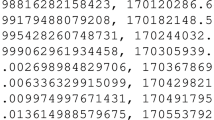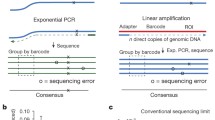Abstract
Comparison of microbial mutation rates under the Luria–Delbrück protocol is a routine laboratory task. However, execution of this important task has been hampered by the lack of proper statistical methods. Visual inspection or improper use of the t test and the Mann–Whitney test can impair the quality of genetic research. This paper proposes a unified framework for constructing likelihood ratio tests that overcome three important obstacles to the proper comparison of microbial mutation rates. Specifically, algorithms for likelihood ratio tests have been devised that allow for partial plating, differential growth rates and unequal terminal cell population sizes. The new algorithms were assessed by computer simulations. In addition, a strategy for multiple comparison was illustrated by reanalyzing the experimental data from a study of bacterial resistance against tuberculosis antibiotics.

Similar content being viewed by others
References
Agresti A (2007) An introduction to categorical data analysis, 2nd edn. Wiley-Interscience, Hoboken
Bachmann H, Starrenburg MJC, Molenaar D, Kleerebezem M, van Hylckama Vlieg JET (2012) Microbial domestication signatures of Lactococcus lactis can be reproduced by experimental evolution. Genome Res 22:115–124
Benjamini Y, Hochberg Y (1995) Controlling the false discovery rate: a practical and powerful approach to multiple testing. J R Stat Soc Ser B 57:289–300
Boe L, Tolker-Nielsen T, Eegholm K-M, Spliid H, Vrang A (1994) Fluctuation analysis of mutations to nalidixic acid resistance in Escherichia coli. J Bacteriol 176:2781–2787
Bolz NJ, Lenhart JS, Weindorf SC, Simmons LA (2012) Residues in the n-terminal domain of MutL required for mismatch repair in Bacillus subtilis. J Bacteriol 194:5361–5367
Cifone MA, Fidler IJ (1981) Increasing metastatic potential is associated with increasing genetic instability of clones isolated from murine neoplasms. Proc Natl Acad Sci 78:6949–6952
Crane GJ, Thomas SM, Jones ME (1996) A modified Luria–Delbrück fluctuation assay for estimating and comparing mutation rates. Mutat Res 354:171–182
Csörgő B, Fehér T, Tímár E, Blattner FR, Pósfai G (2012) Low-mutation-rate, reduced-genome Escherichia coli: an improved host for faithful maintenance of engineered genetic constructs. Microb Cell Fact 11:11
Fehér T, Cseh F, Umenhoffer K, Karcagi I, Pósfai G (2006) Characterization of cycA mutants of Escherichia coli: an assay for measuring in vivo mutation rates. Mutat Res 595:184–190
Flohr RCE, Blom CJ, Rainey PB, Beaumont HJE (2013) Founder niche constrains evolutionary adaptive radiation. Proc Natl Acad Sci USA 110:20663–20668
Ford CB, Shah RR, Meada MK, Gagneux S, Murray MB, Cohen T, Johnston JC, Gardy J, Lipsitch M, Fortune SM (2013) Mycobacterium tuberculosis mutation rate estimates from different lineages predict substantial differences in the emergence of drug-resistant tuberculosis. Nat Genet 45:784–790
Jones ME, Thomas SM, Rogers A (1994) Luria–Delbrück fluctuation experiments: design and analysis. Genetics 136:1209–1216
Lea EA, Coulson CA (1949) The distribution of the numbers of mutants in bacterial populations. J Genet 49:264–285
Luria SE (1984) A slot machine, a broken test tube: an autobiography. Harper & Row, New York
Luria SE, Delbrück M (1943) Mutations of bacteria from virus sensitivity to virus resistance. Genetics 28:491–511
Ma WT, Sandri G vH, Sarkar S (1992) Analysis of the Luria and Delbrück distribution using discrete convolution powers. J Appl Prob 29:255–267
MaGrath M, van Pittius NCG, van Helden PD, Warren RM, Warner DF (2014) Mutation rate and the emergence of drug resistance in Mycobacterium tuberculosis. J Antimicrob Chemother 69:292–302
Monti MR, Miguel V, Borgogno MV, Argaraña CE (2012) Functional analysis of the interaction between the mismatch repair protein MutS and the replication processivity factor \(\beta\) clamp in Pseudomonas aeruginosa. DNA Repair 11:463–469
Painter KL, Strange E, Parkhill J, Bamford KB, Armstrong-James D (2015) Staphylococcus aureus adapts to oxidative stress by producing \({\rm H}_{2} {\rm O}_{2}\)-resistant small-colony variants via the SOS response. Infect Immun 83:1830–1844
Rajanna C, Quellette G, Rashid M, Zemla A, Karavis M, Zhou C, Revazishvili T, Redmond B, McNew L, Bakanidze L, Imnadze P, Rivers B, Skowronski EW, O’Connell KP, Sulkvelidze A, Gibbons HS (2013) A strain of Yersinia pestis with a mutator phenotype from the republic of georgia. FEMS Microbiol Lett 343:113–120
Rosche WA, Foster PL (2000) Determining mutation rates in bacterial populations. Methods 20:4–17
Sabatinos SA, Mastro TL, Green MD, Forsburg SL (2013) A mammalian-like DNA damage response of fission yeast to nucleoside analogs. Genetics 193:143–157
Sánchez A, Sharma S, Rozenzhak S, Roguev A, Krogan NJ, Chabes A, Russell P (2012) Replication fork collapse and genome instability in a deoxycytidylate deaminase mutant. Mol Cell Biol 32:4445–4454
Sarkar S, Ma WT, Sandri G vH (1992) On fluctuation analysis: a new, simple and efficient method for computing the expected number of mutants. Genetica 85:173–179
Schenker N, Gentleman JF (2001) On judging the significance of differences by examining overlap between confidence intervals. Am Stat 55:182–186
Shockley AH, Doo DW, Rodriguez GP, Crouse GF (2013) Oxidative damage and mutagenesis in Saccharomyces cerevisiae: genetic studies of pathways affecting replication fidelity of 8-oxoguanine. Genetics 195:359–367
Stewart FM (1991) Fluctuation analysis: the effect of plating efficiency. Genetica 84:51–55
Walsh BW, Boltz SA, Wessel SR, Schroeder JW, Keck JL, Simmons LA (2014) RecD2 helicase limits replication fork stress in Bacillus subtilis. J Bacteriol 196:1359–1368
Werngren J, Hoffner SE (2003) Drug-susceptible Mycobacterium tuberculosis Beijing genotype does not develop mutation-conferred resistance to rifampin at an elevated rate. J Clin Microbiol 41:1520–1524
Wielgoss S, Barrick JE, Tenaillon O, Wiser MJ, Dittma WJ, Cruveiller S, Chane-Woon-Ming B, Médigue C, Lenski RE (2013) Mutation rate dynamics in a bacterial population reflect tension between adaptation and genetic load. Proc Natl Acad Sci USA 110:222–227
Zheng Q (1999) Progress of a half century in the study of the Luria–Delbrück distribution. Math Biosci 162:1–32
Zheng Q (2005) New algorithms for Luria–Delbrück fluctuation analysis. Math Biosci 196:198–214
Zheng Q (2008) A note on plating efficiency in fluctuation experiments. Math Biosci 216:150–153
Zheng Q (2015a) Methods for comparing mutation rates using fluctuation assay data. Mutat Res Fundam Mol Mech Mutagen 777:20–22
Zheng Q (2015b) A new practical guide to the Luria–Delbrück protocol. Mutat Res Fundam Mol Mech Mutagen 781:7–13
Zheng Q (2016) rSalvador 1.5: an R tool for the Luria–Delbrück fluctuation assay. http://eeeeeric.github.io/rSalvador
Acknowledgments
My special appreciation goes to J. Werngren who explained to me minute experimental details with extraordinary patience. I also own a debt to two conscientious reviewers whose detailed comments substantially improved the presentation of the material in this manuscript. Part of the reported investigation relied heavily on an IBM iDataPlex cluster and an IBM NeXtScale cluster, managed by Texas A&M University Supercomputing Facility.
Author information
Authors and Affiliations
Corresponding author
Rights and permissions
About this article
Cite this article
Zheng, Q. Comparing mutation rates under the Luria–Delbrück protocol. Genetica 144, 351–359 (2016). https://doi.org/10.1007/s10709-016-9904-3
Received:
Accepted:
Published:
Issue Date:
DOI: https://doi.org/10.1007/s10709-016-9904-3




